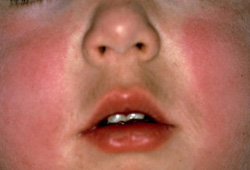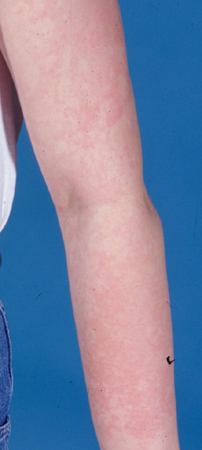Aetiology
Erythema infectiosum is caused by parvovirus B19, a single-stranded, non-enveloped DNA virus. Parvovirus B19 is distributed worldwide. Humans are the only known hosts. Members of the family parvoviridae are frequent causes of infection in veterinary medicine but animal parvoviruses are not a cause of human infection.[17]
Pathophysiology
Parvovirus B19 infects erythrocyte progenitor cells, using the erythrocyte P antigen (globoside) as its receptor.[18] Individuals lacking the P antigen are not susceptible to the disease. The affinity for erythrocyte progenitors explains the complications that may be seen as a result of parvovirus B19 infection. In the fetus, with decreased red-cell survival time, infection may lead to haemolysis and hydrops fetalis. In patients with increased red-cell turnover or loss, the parvovirus-induced decrease in production can result in a transient aplastic crisis.[19]
The incubation period from virus acquisition to onset of first symptoms is usually 4-14 days, but it can be as long as 21 days.[20]
Classification
Age of onset
Child: the classic childhood presentation is a 'slapped cheek' appearance followed by a reticular, erythematous eruption that is predominantly found on the extremities. [Figure caption and citation for the preceding image starts]: Typical erythematous 'slapped cheeks' of erythema infectiosum.From the collection of Gary A. Dyer, MD; used with permission [Citation ends]. [Figure caption and citation for the preceding image starts]: Lacy, reticular, erythematous eruption of erythema infectiosum on an upper extremity.From the collection of Gary A. Dyer, MD; used with permission [Citation ends].
[Figure caption and citation for the preceding image starts]: Lacy, reticular, erythematous eruption of erythema infectiosum on an upper extremity.From the collection of Gary A. Dyer, MD; used with permission [Citation ends].
Adult: self-limited arthropathy of the small joints is often the most common presenting complaint and may or may not be accompanied by the typical exanthem.
Pregnancy: infection is associated with an increased risk of fetal complications including severe anaemia, fetal hydrops, or intrauterine death.
Use of this content is subject to our disclaimer